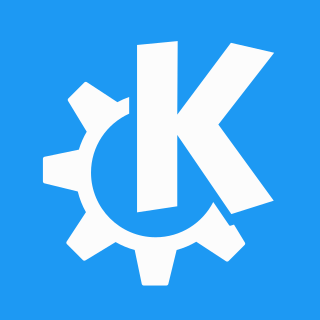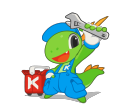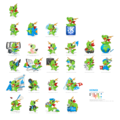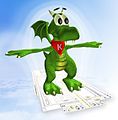
Calligra Suite is a graphic art and office suite by KDE. It is available for desktop PCs, tablet computers, and smartphones. It contains applications for word processing, spreadsheets, presentation, databases, vector graphics, and digital painting.

Window Maker is a free and open-source window manager for the X Window System, allowing graphical applications to be run on Unix-like operating-systems. It is designed to emulate NeXTSTEP's GUI as an OpenStep-compatible environment. Window Maker is part of the GNU Project.
The OS-tan is an Internet meme that originated within the Japanese Futaba Channel. The OS-tan are the moe anthropomorphism/personification of several operating systems by various amateur Japanese artists. The OS-tan are typically depicted as women, with the OS-tan representative of Microsoft Windows operating systems usually depicted as sisters of varying ages. The -tan element in the term is a hypocoristic suffix from Japanese.

The KDE Advanced Text Editor (Kate) is a text editor developed by the KDE free software community. It has been a part of KDE Software Compilation since version 2.2, which was first released in 2001. Intended for software developers, it features syntax highlighting, code folding, customizable layouts, regular expression support, and extensibility.

The BSD Daemon, nicknamed Beastie, is the generic mascot of BSD operating systems.
XMLGUI is a KDE framework for designing the user interface of an application using XML, using the idea of actions.

Krita is a free and open-source raster graphics editor written in Qt and designed primarily for digital painting and animation purposes. It features OpenGL-accelerated canvas, colour management support, an advanced brush engine, non-destructive layers and masks, group-based layer management, vector artwork support and switchable customisation profiles. It runs on Windows and Unix-like OSes.

KDE Software Compilation 4 was the only series of the so-called KDE Software Compilation, first released in January 2008 and the last release being 4.14.3 released in November 2014. It was the follow-up to K Desktop Environment 3. Following KDE SC 4, the compilation was broken up into basic framework libraries, desktop environment and applications, which are termed KDE Frameworks 5, KDE Plasma 5 and KDE Applications, respectively.

KDE Platform 4 was a collection of libraries and software frameworks by KDE that served as technological foundation for KDE Software Compilation 4 distributed under the GNU Lesser General Public License (LGPL). KDE Platform 4 was the successor to KDElibs and the predecessor of KDE Frameworks. KDE Platform 4 is the only version of KDE Platform, see KDE’s brand repositioning.

KDE Plasma 4 is the fourth generation of the KDE workspace environments. It consists of three workspaces, each targeting a certain platform: Plasma Desktop for traditional desktop PCs and notebooks, Plasma Netbook for netbooks, and Plasma Active for tablet PCs and similar devices.

K Desktop Environment 3 is the third series of releases of the K Desktop Environment. There are six major releases in this series. After the release of KDE 4, version 3.5 was forked into the Trinity Desktop Environment.

Tux is a penguin character and the official brand character of the Linux kernel. Originally created as an entry to a Linux logo competition, Tux is the most commonly used icon for Linux, although different Linux distributions depict Tux in various styles. The character is used in many other Linux programs and as a general symbol of Linux.
OpenRaster is a file format proposed for the common exchange of layered images between raster graphics editors. It is meant as a replacement for later versions of the Adobe PSD format. OpenRaster is still in development and so far is supported by a few programs. The default file extension for OpenRaster files is ".ora".

The KDE Software Compilation was an umbrella term for the desktop environment plus a range of included applications produced by KDE. From its 1.0 release in July 1998 until the release of version 4.4 in February 2010, the Software Compilation was simply known as KDE, which stood for K Desktop Environment until the rebrand. The then called KDE SC was used from 4.4 onward until the final release 4.14 in July 2014. It consisted of the KDE Plasma 4 desktop and those KDE applications, whose development teams chose to follow the Software Compilation's release schedule. After that, the KDE SC was split into three separate product entities: KDE Plasma, KDE Frameworks and KDE Applications, each with their own independent release schedules.

KDE neon is a Linux distribution developed by KDE based on the most recent Ubuntu long-term support (LTS) release, bundled with a set of additional software repositories containing the latest 64-bit versions of the Plasma 5 desktop environment/framework, Qt 5 toolkit and other compatible KDE software. First announced in June 2016 by Kubuntu founder Jonathan Riddell following his departure from Canonical, it has been adopted by an steadily growing number of Linux users, regularly appearing in the Top 20 on DistroWatch.com's popularity tables. It targets the same user demographic as Ubuntu's official KDE Plasma-focused distribution, Kubuntu, differing primarily in the much shorter time-frame for users to receive updated Qt and KDE software. It is offered in four release channels: User, Testing, Unstable and Developer Editions.

KDE Projects are projects maintained by the KDE community, a group of people developing and advocating free software for everyday use, for example KDE Plasma and KDE Frameworks or applications such as Amarok, Krita or Digikam. There are also non-coding projects like designing the Breeze desktop theme and iconset, which is coordinated by KDE's VisualDesignGroup. Even non-Qt applications like GCompris, which started as a GTK-based application, or web-based projects like WikiToLearn are officially part of KDE.

























































